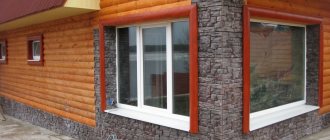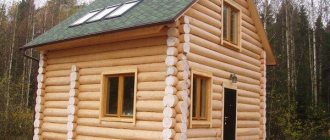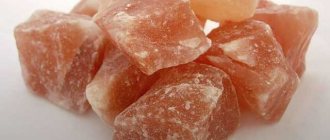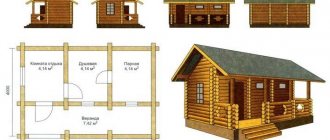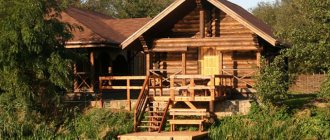Let's start with the fact that using a lampshade in a bathhouse automatically assumes that a point light source .
Because LED strip lights don't need anything like that. The following clarification concerns rooms in which lampshades can be used. So the main function of this part of the lamp is to slightly dim the light from the lamp; it is appropriate to use them in any of them, especially since the lampshade is also one of the varieties (however, now we use this word not only for round ceiling shapes, but many glass products scatter light).
Since the choice of item is determined by such factors as the style of the interior, the taste of the owner and his financial capabilities, we will limit the topic of our article to the decorative elements of the lamps that are used in the steam room - there are a number of restrictions associated with them that you should know.
Requirements
IMPORTANT! Specific lampshades in the bathhouse are used only in the steam room; in all other rooms they can be used as in the corresponding rooms of a residential building.
The lamp as a whole should not be afraid of moisture. Since you are conducting electricity into a damp room, you should take utmost care to ensure that it does not come into contact with water. And for greater safety, you should connect an RCD (if you have questions about the theory of bathhouse electrics or its practical application in a bathhouse, follow the links, we have detailed materials on these topics).
So, tightness comes first. And for a steam room, heat resistance is also important - the lamp should not be destroyed by high temperature.
Well, it’s also environmentally friendly - it’s impossible for any harmful organic matter to evaporate from it under the influence of temperature.
And fire safety - it should not support combustion.
You will learn about which lamps can be installed in a bathhouse and which ones can be installed in a sauna by following the links. A separate material combines information about the light in the steam room.
We also have material entirely dedicated to LED light sources.
The most beneficial uses of Himalayan salt
Cylindrical and prismatic, round, square, monolithic and stacked shades and lampshades installed on an incandescent lamp immediately acquire several useful qualities:
- They diffuse the light in the bathhouse very beautifully. According to most professional decorators, the brownish and honey-yellow light of an ideal Himalayan salt lamp looks much more natural and attractive;
- Heated by the diffused light of an incandescent lamp, the salt surface acquires the ability to dry the air in a certain way and saturate it with OH ions, giving the atmosphere inside the bathhouse a slightly tart, but quite pleasant aroma.
It is believed that lamps and heated tiles act as air sterilizers. Of course, this only applies to microbes in the sauna air and in contact with heated Himalayan salt. But businessmen intensively exploit the healing effect of halite, attributing to it medicinal properties for a huge list of diseases.
Types of illuminated walls
Installation of brick panels using Himalayan salt adhesive
This installation method, in our opinion, is the most preferable: we get a monolithic structure that will hold securely and will not require further maintenance.
With this installation method, it would, of course, be appropriate to use a fiber optic kit with the projector. If you choose an LED strip or tube, you will need to organize access behind the wall (if possible), or accept the fact that when the strip (tube) burns out, the wall will no longer be illuminated.
You can purchase adhesive composition for salt products from anyone who sells Himalayan salt. It is usually mixed with water in a certain proportion, and does not set immediately. After this composition has completely hardened, your wall becomes monolithic. It is important to note that when using bricks, you most likely will not need to prop up the wall while it dries, since the salt brick will be held up due to its width. To fix it in a horizontal plane in the room being used, it is necessary to use support strips from the inside and layouts from the outside.
The finished version looks like this:
Installation of tile panels using Himalayan salt adhesive
Unlike brick, tiles will most likely not hold up when the mortar dries, so the structure must be supplemented with temporary support. You will also need constant support, because even after the mortar has completely set, a tile wall will not be as stable as a brick wall. As a permanent support, you can use a large metal mesh on which the panel will rest.
It is also necessary to provide for attaching the salt panel to the mesh, because we do not have any support in front. In the photo, the salt tile is tied with a nylon thread threaded through a mesh, i.e. we actually tie our panel to a grid, as a result of which it is fixed in space.
Recommendations for the light source are the same as in the first paragraph.
The result will look like this:
"Dry" installation
In our opinion, the least justified type of installation is associated with a number of inconveniences and further maintenance.
I’ll say right away that due to the complexity of maintenance and the unsuitable quality of the source material, we currently do not use this type of installation.
Safety precautions and operating rules for homemade lighting devices
When making a homemade lamp, you must follow the safety rules:
Lamps must be protected with special shades
They are made of glass, which can be transparent or frosted. It is important to insulate the wires with special plugs. You need to choose materials that are resistant to frequent temperature changes and moisture. After assembling a homemade lamp, you need to check its functionality
After assembling a homemade lamp, you need to check its functionality.
Lamps in the bathhouse create a certain level of comfort. Therefore, you need to take the issue of choosing lighting with great responsibility.
Material
In principle, the material can be stainless metal or glass, but we are talking about a bathhouse, or rather, even a steam room, so metal can be immediately rejected, because it will heat up and can burn. Glass…
Glass
Using glass in a steam room and washing room is quite acceptable if we are talking about a matte lampshade that hermetically protects the light bulb inside from water. Actually, there is not much choice here - you need a translucent material that transmits light well. Plastic is not suitable for a steam room (we note in parentheses that it is not suitable even if it is produced by Harvia).
ATTENTION! However, we are not talking about decorative lampshades, which also have a protective function. Only the cap that directly covers the light bulb can be glass.
Decorative parts are made from other materials, which are discussed below.
Wooden
In this case, wood should be considered the optimal material, given that the vast majority of owners choose it as a finishing material. So, in a log house or in a clapboard-lined steam room, a wooden structure will look best.
Wood differs depending on the type of wood. Of course, there is not always a choice, but listen to our words:
ADVICE! Do not use coniferous species when making a wooden lampshade for a bathhouse, because lamps, in addition to light, also emit heat, and coniferous ones have the unpleasant property of releasing resin when the temperature rises.
Any deciduous tree will do. Only if you are going to do something delicate, then softer species, such as linden or aspen, are suitable, and any tree is suitable for a more simple design.
With Himalayan salt
Himalayan salt in this case is used as a light-diffusing screen. This is possible both when choosing plates from it, and when filling the container with lump material.
Rock salt, of course, is harder than table salt, but its composition is approximately the same (with the exception of various additives such as iron, which gives it a reddish tint, and other salts - for example, sulfates, borates). What this means, first of all, is that under the influence of moisture and heat, halite (the name of the mineral is the same as “rock salt”) will slowly but steadily dissolve.
Regarding the fact that the effect of salt is healing... Well, NaCl (sodium chlorine) there is exactly the same as in a salt shaker. Other supplements are somehow not necessarily useful, like vitamins. Why do you need sulfur or boron salts? Microelements - if they are really released as actively as they say - will not interfere, we will not argue.
With your own hands
Even a beginner can handle making a corner screen like this:
To work, you will need a jigsaw/jigsaw, sandpaper/sander. Actually, you won’t even need a hacksaw if the bars are not very thick. The material is moisture-resistant plywood or thin furniture board and thin timber , self-tapping screws, wall fasteners - lugs, for example.
- First of all, decide on the size and cut out a screen from a sheet of plywood or panel.
- Mark the outlines of the future design on it and cut it out using a jigsaw or jigsaw.
- Sand the finished screen.
- Cut a thin beam as follows: the hypotenuse of the future triangle will be the width of the screen, and to it you can easily calculate the lengths of the legs, taking into account that the angle with the hypotenuse is 45 degrees. You need to make two such triangles to attach the screen at the top and bottom.
- The finished triangles are fastened with self-tapping screws and then attached to the screen.
- Ears are placed on triangles.
- All that remains is to protect the tree from moisture and you can hang it.
Sauna lampshade: design
Regardless of the chosen material and shape of the future lamp, there are two standard types of design that are designed to be placed either along the wall or in one of the corners.
Corner
This design is considered more compact, as it occupies space that is usually empty during soaring procedures. Therefore, there are fewer options for awkwardly touching or breaking, and the light spreads along two walls at the same time.
In the “top view” projection, it is either a triangle or a trapezoid. This allows it to be mounted on both walls, providing greater stability.
Wall-mounted
The corner location is not always optimal. Then you can use the option of placing the lampshade on the wall surface.
ADVICE! If possible, step back some distance from the ceiling; in a steam room, it is not advisable to mount lamps on the ceiling or directly below it, because the hottest air and steam collects near the ceiling.
Wall-mounted options can be quite varied in design, but when placing it, it is worth considering the convenience of steamers and the direction of light on the objects used in the steam room.
Lamp
As a rule, lamps made from pieces of salt are factory-made, and bathhouse owners most often go to the store to buy a ready-made product, although you can make it yourself.
The easiest way to use Himalayan salt in a bathhouse is to secure a wooden basket in a pre-selected place in the bathhouse, into which salt is poured in the form of small pieces or coarsely ground pebbles. An ordinary light bulb (preferably LED) of a warm color is attached to the inside of the basket for illumination. This option is the most budget-friendly option for a lamp made from Himalayan pink salt.
A somewhat more complex and expensive, but also more advantageous way to use salt tiles for a bath is to create a full-fledged portable lamp from Himalayan salt tiles. To do this, the tiles are laid in a special way - in the form of a box without a bottom. Individual tiles can be secured to each other either using special glue or with clamps made of metal or any other durable material.
The assembled lamp must be mounted on a base made of wood or plastic, made in the form of a regular plate (for example, a sheet of plywood). The socket with the lamp is also brought from below and fixed to the base so that the lamp itself does not touch the walls of the lamp.
Basic principles
In order to make a backlit panel in the steam room, you need to leave a gap of 3-6 cm between the bricks (tiles) and the wall in which the light sources will be located. This gap is necessary, firstly, in order to somehow position the light sources behind the salt, and secondly, so that there is the necessary space for the spread of reflected light. Why exactly reflected? The fact is that if you simply place a powerful light source, it will shine brightly only in one place, that is, it will be point-like. We need to create as uniform illumination as possible. This is achieved only through reflection and re-reflection. The light will be reflected from the foil or film located behind the light sources; be reflected - from the inner surface of the salt itself. How brightly the panel will glow depends on:
- power of light sources;
- the effectiveness of their reflection;
- the thickness of the panel itself.
Everything is clear with the first two points, but what about the thickness? Depending on whether you choose tile or brick, your design will be different.
You can choose a lighting option based on the criterion of replacing light sources: either the element itself is located directly behind the salt, or it is located in another place. Sources that are behind the salt - LED strips (tubes), incandescent lamps; outside the panel there is a projector with an LED that illuminates the panel through an optical fiber. Accordingly, to replace the LED strip, you will need access to its installation site. There are two access options: behind the wall or in front, i.e. dismantling the wall. In the case of fiber optics, the projector must be replaced, which may be located outside the steam room, or under shelves (with a service life of 50,000 hours, this is unlikely to be necessary).
Correct lighting for the washing area
In a small wash room, 1 lamp will be enough. The lampshade must be sealed to prevent water splashing on the lamp and/or socket.
Wiring for lighting fixtures in the bathhouse must be insulated especially carefully. This will prevent accidental contact of moisture and electricity.
Lighting in the washing room should also be moisture-proof
A large wash room requires the installation of several lamps. Therefore, when choosing their location, you need to take into account the location of the bathtub, sink, bidet, shower stall. It is better to do preliminary zoning of the premises.
As a rule, the washing room is divided into 3 zones:
- in close proximity to a source of moisture;
- at a distance of 0.6 m;
- in a relatively dry space.
Moisture levels are highest near a water source. Therefore, in this area you can install 12 volt bath lamps and lamps. IP indicator for protection against moisture is at least 45 units.
A zone located approximately 60 cm from a direct source of moisture is considered remote from moisture. Here you can use lamps and lamps with an average level of protection.
LED lighting can even be used in a swimming pool
In a dry area, located away from faucets, shower heads, swimming pools, etc., you can use lighting fixtures and lamps with the lowest level of protection.
Bath lampshade: shape
An interesting point: somehow it happened historically that there are two main forms - a grille and a screen. We will assume that other options, if they existed, died out due to some kind of unsuitability or inconsistency. Or the survivors turned out to be the simplest and most practical. (Of course, no one forbids doing something original; we are talking about the most common.)
Lattice
The question arises: what else could be made from slats or solid planks? The simplest and most effective way is to assemble a lattice, a kind of “fence,” leaving slits for light.
IMPORTANT! The brightness of the lighting depends on the width and number of slots.
However, even with the simplicity of the idea, variations can be sufficient - the slats can be attached to bases that will give the structure a cylindrical or conical shape, or they will be combinations of simple shapes, if you like.
Salt lamp color tone
The white color of the mineral, when illuminated, can set off different color tones. They depend both on the color electronic element and on the natural impurities present in the salt (algae, various minerals). Before purchasing, you should know which color suits whom best. The following review will allow you to decide on the color of the lamp. At the same time, we should not forget that regardless of the additional potential of light, salt has a positive effect on the entire body.
- Light yellow – helps to activate mental and intellectual abilities, has a positive effect on the restoration processes of the pancreas, liver and gall bladder.
- White is more about cleaning and disinfecting the body.
- Orange is good for the nervous system and enhances the body’s ability to better cope with stressful situations. Allows you to feel security and stability.
- Brown tones have a positive effect on the condition of the entire body.
- Pink is the color of romance and dreams, enhancing the emotional perception between partners.
- Red – recommended for heart diseases, improves the functioning of the heart, cardiovascular system, and increases the vitality of the body.
When purchasing a lamp, pay attention to the origin of the minerals. They are mined in the mines of the Himalayas (Himalayan white minerals), in Pakistan, in the Ukrainian Soledar. The mineral contains approximately 97% sodium chloride; there are compounds of magnesium, potassium and calcium in different proportions.
Selecting a light source
Fiber Optic Spot Lighting
The most suitable option, in our opinion.
It does not require replacement of lamps (the service life of the LED in the projector is 50,000 hours).
The fiber can withstand temperatures up to 180 °C.
You can vary the brightness of the lighting by the number of points used per meter.
There is only one drawback - the relatively high cost.
Linear fiber optic lighting
The most expensive option.
Due to the design features, it will not be possible to install it everywhere, because... The fiber length of all rulers is the same, and the rulers themselves are installed at different distances from the projector.
Withstands lower temperatures than dots (80 °C).
LED tubes
We are talking about tubes from manufacturers of sauna equipment.
They have a protective box, which makes it possible to operate them at high temperatures.
After the tube burns out, it needs to be replaced.
The tubes have a set of fixed lengths.
LED strips
Such tapes are produced, among other things, by manufacturers of equipment for the construction of saunas. They have a protective shell, thanks to which they can be used at high temperatures.
After burnout, they require replacement.
Despite the protective sheath, such tapes are still not designed to withstand the same high temperatures as optical fiber.
How to use a salt lamp
Those who decide to buy a salt lamp should know how to use this device. After purchase, the device must adapt to the room, adjust to the microclimate and humidity. Therefore, for the first few days, preparations are underway, the lamp is turned on for an hour during the day, and gradually, every day, the operating time increases.
The scheme is simple: the first day - 1 hour, the second day - 2 hours, and so on. On the fifth day, the device enters full-function mode with operation for 5 hours. After this, you can use the lamp at night with an operating mode of 6-8 hours. For night use, choose a device equipped with a light intensity controller.

